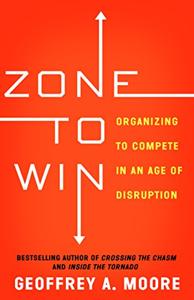
Want to learn the ideas in Zone To Win better than ever? Read the world’s #1 book summary of Zone To Win by Geoffrey A. Moore here.
Read a brief 1-Page Summary or watch video summaries curated by our expert team. Note: this book guide is not affiliated with or endorsed by the publisher or author, and we always encourage you to purchase and read the full book.
Video Summaries of Zone To Win
We’ve scoured the Internet for the very best videos on Zone To Win, from high-quality videos summaries to interviews or commentary by Geoffrey A. Moore.
1-Page Summary of Zone To Win
Overview
Many years ago, the idea of a handheld device with the power of a supercomputer seemed like science fiction. But in 2007, Apple released the iPhone and changed everything. Nokia crumbled; Samsung soldiered on.
In today’s fast-paced world, it can be difficult to stay ahead of the competition. However, if you follow this four zones system, you’ll not only succeed in doing so but also learn how to disrupt your market and dominate your rivals.
In this article, you’ll learn how to keep a product relevant after a disruption in the market. You will also learn when it’s good to focus on innovation and when it’s not. Finally, you’ll find out how Microsoft got innovative in order to stay afloat in the mobile market.
Big Idea #1: Companies need to innovate to keep growing, yet such a disruption necessarily has a ripple effect.
Companies need to be innovative in order to grow. They should introduce a new product or service that will turn their industry on its head, like online marketing. This can lead to rapid growth and 20% revenue increases over the first five years of introducing a new product or service.
On the other hand, if you miss an innovation wave, you can’t catch up later. You’re better off looking for another opportunity to innovate. For example, Apple found three different waves of innovation in the mobile market: digital music, smartphones and tablets. The company completely transformed that market by catching those waves of innovation.
Disruptive innovations can completely change the way industries operate. The iPhone changed the mobile phone industry, but it also affected other areas of business as well. For example, airlines had to rethink their check-in and boarding procedures in order to accommodate smartphones. In addition, they had to make significant investments without seeing immediate profits from those changes.
So, disruptive changes can be difficult for companies to handle. This is why it’s essential to know how to manage those disruptions when they happen.
Big Idea #2: Established companies can compete with disruptive start-ups by creating four zones of management.
If you’re dating in your 30s, it’s a competitive market. You have to change your strategy if you want to compete with younger people.
In the same vein, established companies should be able to compete with new and disruptive start-ups. However, they need to restructure their business models first in order to do so. Restructuring is important because a new company can easily upend an existing enterprise. Start-ups are focused on building a product while established companies have to maintain current business models as well as handle market disruptions at the same time. Journalism is an example of this – print media has lost power due to digital technology and smartphones over the last 15 years, resulting in subscription numbers plummeting and many journalists losing their jobs
To be successful in today’s world, companies need to restructure their operations into four zones.
There are two types of employees: the first type is called the performance zone. This group consists of people who sell an existing product or generate direct income for a company. In the automotive industry, those individuals would be car salespeople and other employees that make money directly from selling cars to customers.
The second zone is the productivity zone. This encompasses all activity that helps generate revenue but isn’t directly related to generating revenue, such as producing cars, marketing the company brand and providing customer service.
The third type of group is the incubation zone. This group focuses on finding new ways to grow and improve the company. For example, an incubation zone for a car manufacturer might focus on developing more efficient engines.





